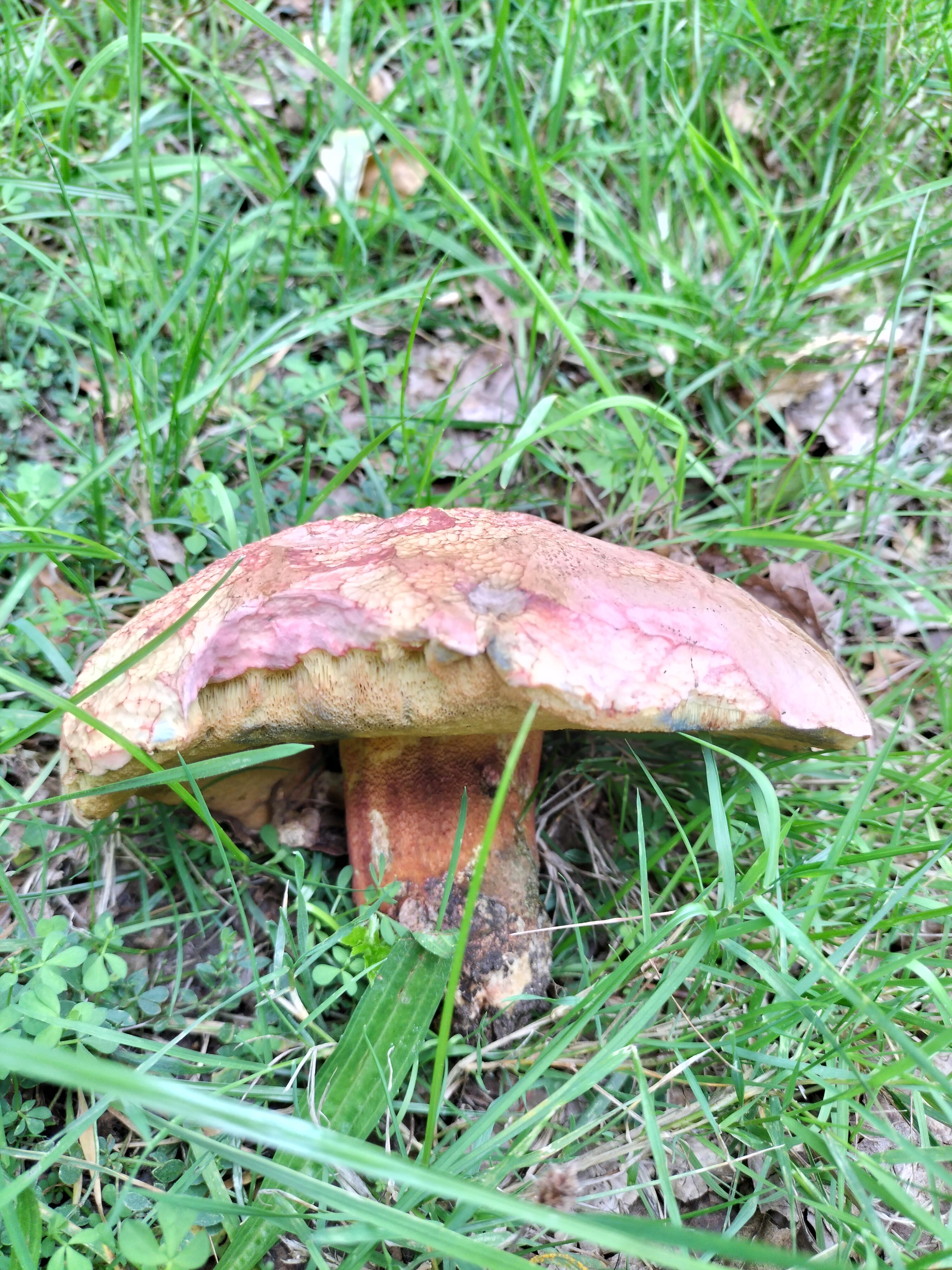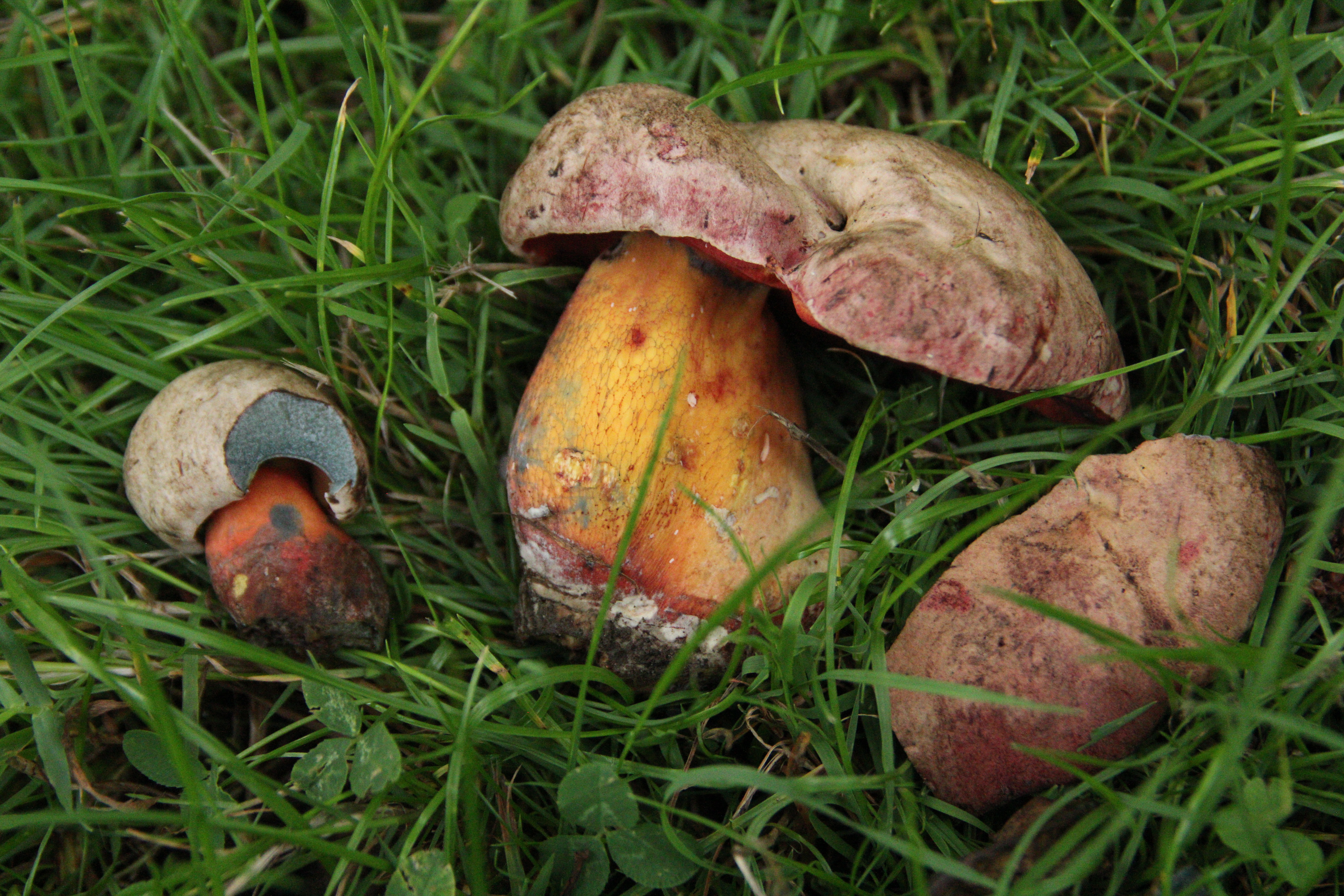Rubroboletus Legaliae on:
[Wikipedia]
[Google]
[Amazon]
''Rubroboletus legaliae'', previously known as ''Boletus splendidus'', ''B. satanoides'', and ''B. legaliae'' is a


basidiomycete
Basidiomycota () is one of two large divisions that, together with the Ascomycota, constitute the subkingdom Dikarya (often referred to as the "higher fungi") within the kingdom Fungi. Members are known as basidiomycetes. More specifically, Basid ...
fungus
A fungus (: fungi , , , or ; or funguses) is any member of the group of eukaryotic organisms that includes microorganisms such as yeasts and mold (fungus), molds, as well as the more familiar mushrooms. These organisms are classified as one ...
of the family Boletaceae
The Boletaceae are a Family (biology), family of mushroom-forming fungi, primarily characterised by small pores on the spore-bearing hymenium, hymenial surface (at the underside of the mushroom), instead of Lamella (mycology), gills as are found ...
. It is poisonous
A poison is any chemical substance that is harmful or lethal to living organisms. The term is used in a wide range of scientific fields and industries, where it is often specifically defined. It may also be applied colloquially or figurati ...
, with predominantly gastrointestinal symptom
Gastrointestinal diseases (abbrev. GI diseases or GI illnesses) refer to diseases involving the gastrointestinal tract, namely the esophagus, stomach, small intestine, large intestine and rectum; and the accessory organs of digestion, the liver, ...
s, and is related to '' Rubroboletus satanas''.
''Boletus legaliae'' was described by Czech mycologist
Mycology is the branch of biology concerned with the study of fungi, including their taxonomy, genetics, biochemical properties, and use by humans. Fungi can be a source of tinder, food, traditional medicine, as well as entheogens, poison, and ...
Albert Pilát
Albert Pilát (November 2, 1903 – May 29, 1974) was a Czech botany, botanist and mycology, mycologist. He studied at the Faculty of Science at Charles University, under the guidance of Professor Josef Velenovský. In 1930, he joined the Nationa ...
in 1968. It is named after the French mycologist Marcelle Le Gal.
It's uncommon in Southern England
Southern England, also known as the South of England or the South, is a sub-national part of England. Officially, it is made up of the southern, south-western and part of the eastern parts of England, consisting of the statistical regions of ...
, and Europe
Europe is a continent located entirely in the Northern Hemisphere and mostly in the Eastern Hemisphere. It is bordered by the Arctic Ocean to the north, the Atlantic Ocean to the west, the Mediterranean Sea to the south, and Asia to the east ...
, and grows with oak (''Quercus
An oak is a hardwood tree or shrub in the genus ''Quercus'' of the beech family. They have spirally arranged leaves, often with lobed edges, and a nut called an acorn, borne within a cup. The genus is widely distributed in the Northern Hemisp ...
'') and beech (''Fagus
Beech (genus ''Fagus'') is a genus of deciduous trees in the family Fagaceae, native to subtropical (accessory forest element) and temperate (as dominant element of Mesophyte, mesophytic forests) Eurasia and North America. There are 14 accepted ...
'') often on neutral to acid soils. It is considered vulnerable in the Czech Republic. In Britain, all of the boletes in the ''Satanas'' group are either very rare, endangered, or extinct.
Description
Thecap
A cap is a flat headgear, usually with a visor. Caps have crowns that fit very close to the head. They made their first appearance as early as 3200 BC. The origin of the word "cap" comes from the Old French word "chapeau" which means "head co ...
is initially off-white, or coffee-coloured at the button stage. In mid life it often (but not always) turns a pale mouse grey. In old age the cap turns reddish, or what has been described as 'old rose'. It may reach in diameter.
The stipe is stocky, with a narrow red reticulation (net pattern) on an orange ground at the apex. This orange ground colour fades gradually towards the midsection, making the red reticulation more pronounced. At the base the reticulation is absent, and the stipe turns dark vinaceous. Sometimes the stipe detail can be faint, or even absent when covered with earth or leaf litter. The pores are initially red, but have an overall orange colour when mature, and they bruise blue. The flesh turns pale blue on cutting / dark vinaceous in the stipe base. Often this blueing process is very slow, sometimes taking a minute or so for the flesh to turn a light blue. In other situations, blueing is near-instant. The flesh is said to smell of chicory
Common chicory (''Cichorium intybus'') is a somewhat woody, perennial herbaceous plant of the family Asteraceae, usually with bright blue flowers, rarely white or pink. Native to Europe, it has been introduced to the Americas and Australia.
M ...
.
''Boletus splendidus'' as described by Charles-Édouard Martín in 1894 is a synonym
A synonym is a word, morpheme, or phrase that means precisely or nearly the same as another word, morpheme, or phrase in a given language. For example, in the English language, the words ''begin'', ''start'', ''commence'', and ''initiate'' are a ...
. The description of ''Boletus satanoides'' was too vague to be ascribed to any actual species. ''Boletus legaliae'' was transferred to the genus '' Rubroboletus'' in 2015 by Marco Della Maggiora and Renzo Trassinelli.
Occurrence in the UK
R. legaliae is an uncommon to rare species in the UK, commonly occurring in open woodland or parkland with plenty of sun on neutral-to-acidic soil. Assessed as 'Vulnerable' by the JNCC, it has a population of around 560 mature specimens. An unusual morph with bright yellow pores has been recorded from Windsor Great Park, Berkshire, sometimes growing alongside normal-pored variants.A.M. Ainsworth, J.H. Smith, L. Boddy, B.T.M. Dentinger, M. Jordan, D. Parfitt, H.J. Rogers & S.J. Skeates. 2013. Red List of Fungi for Great Britain: Boletaceae; A pilot conservation assessment based on national database records, fruit body morphology and DNA barcoding Species Status 14. Joint Nature Conservation Committee, Peterborough.

Similar species
'' Rubroboletus satanas'', found in broad-leaved woodland on calcareous soil, has a whitercap
A cap is a flat headgear, usually with a visor. Caps have crowns that fit very close to the head. They made their first appearance as early as 3200 BC. The origin of the word "cap" comes from the Old French word "chapeau" which means "head co ...
that turns brownish-ochre, lacking the overall reddish tones in maturity. It has a more nauseating smell.
Molecular study of the holotype of '' Rubroboletus spinari'' has demonstrated its conspecifity with ''Rubroboletus legaliae''.
References
{{Taxonbar, from=Q2656745 Poisonous fungi legaliae Fungi of Europe Fungi described in 1968 Fungus species